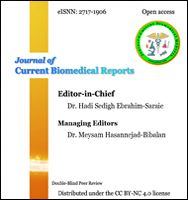Anti-bacterial effect of white tea extract on Streptococcus mutans and Streptococcus salivarius
Abstract
Due to the increasing frequency of drug-resistant strains among different types of microorganisms, the finding of antimicrobial and antifungal compounds of natural substances, which certainly has fewer side effects, has long been of interest to researchers. Therefore, the aim of this investigation was to study the effect of white tea extract on reducing Streptococcus mutans and Streptococcus salivarius. White tea was prepared in powder form and then its hydroalcoholic extract of it was prepared. The antimicrobial effects of extracts on S. mutans and S. salivarius were performed using well diffusion and broth microdilution methods. All experiments were performed in triplet replications. Antibacterial susceptibility testing revealed that white tea extract at concentration of 500 µg/ml had a remarkable antibacterial activity against S. mutans, and S. salivarius with a zone of inhibition, 25±1 mm and 30±1, respectively. The minimum inhibitory concentration (MIC) values of the both tested strains were estimated 31.25 µg/ml. Moreover, the minimum bactericidal concentration (MBC) values of white tea extract were estimated 62.5 µg/ml against both streptococci. Considering the inhibitory power of the white tea extract on the gram-positive bacteria of S. salivarius and mutans, it can be concluded that this plant can be used in various industries, including the pharmaceutical and sanitary industry and it can also improve oral health as S. mutans and salvarius are the most important bacteria causing decays.
Keywords
References
Granato D, Prado-Silva Ld, Alvarenga VO, Zielinski AAF, Bataglion GA, Morais DRd, et al. Characterization of binary and ternary mixtures of green, white and black tea extracts by electrospray ionization mass spectrometry and modeling of their in vitro antibacterial activity. LWT - Food Sci Technol. 2016; 65:414-20.
Ghoochani M, Shekoohiyan S, Yunesian M, Nazmara S, Mahvi AH. Determination of aluminum and zinc in infusion tea cultivated in north of Iran. J Environ Health Sci Eng. 2015; 13:49.
Pastoriza S, Mesías M, Cabrera C, Rufián-Henares JA. Healthy properties of green and white teas: an update. Food Funct. 2017; 8(8):2650-62.
Dai W, Xie D, Lu M, Li P, Lv H, Yang C, et al. Characterization of white tea metabolome: Comparison against green and black tea by a nontargeted metabolomics approach. Food Res Int. 2017; 96:40-5.
Espinosa Ruiz C, Cabrera L, López-Jiménez J, Zamora S, Pérez-Llamas F. Effects of long-term ingestion of white tea on oxidation produced by aging and acute oxidative damage in rats. J Physiol Biochem. 2018; 74(1):171-7.
Gul P, Akgul N, Seven N. Anticariogenic potential of white cheese, xylitol chewing gum, and black tea. Eur J Dent. 2018; 12(2):199-203.
Siddiqui MW, Sharangi AB, Singh JP, Thakur PK, Ayala-Zavala JF, Singh A, et al. Antimicrobial Properties of Teas and Their Extracts in vitro. Crit Rev Food Sci Nutr. 2016; 56(9):1428-39.
Jose P, Sanjeev K, Sekar M. Effect of Green and White Tea Pretreatment on Remineralization of Demineralized Dentin by CPP-ACFP-An Invitro Microhardness Analysis. J Clin Diagn Res. 2016; 10(4):Zc85-9.
Simpson A, Shaw L, Smith AJ. The bio-availability of fluoride from black tea. J Dent. 2001; 29(1):15-21.
Sounah SA, Madfa AA. Correlation between dental caries experience and the level of Streptococcus mutans and lactobacilli in saliva and carious teeth in a Yemeni adult population. BMC Res Notes. 2020; 13(1):112.
Higuchi T, Suzuki N, Nakaya S, Omagari S, Yoneda M, Hanioka T, et al. Effects of Lactobacillus salivarius WB21 combined with green tea catechins on dental caries, periodontitis, and oral malodor. Arch Oral Biol. 2019; 98:243-7.
Nanda A, Saravanan M. Biosynthesis of silver nanoparticles from Staphylococcus aureus and its antimicrobial activity against MRSA and MRSE. Nanomedicine. 2009; 5(4):452-6.
CLSI (Ed.), 2020. Performance Standards for Antimicrobial Susceptibility Testing; 30th ed. CLSI Supplement M100. Clinical and Laboratory Standards Institute, Wayne, PA.
Zarei M, Jamnejad A, Khajehali E. Antibacterial effect of silver nanoparticles against four foodborne pathogens. Jundishapur J Microbiol. 2014; 7(1):e8720.
Taguri T, Tanaka T, Kouno I. Antimicrobial activity of 10 different plant polyphenols against bacteria causing food-borne disease. Biol Pharm Bull. 2004; 27(12):1965-9.
Fukai K, Ishigami T, Hara Y. Antibacterial activity of tea polyphenols against phytopathogenic bacteria. Agric Biol Chem. 1991; 55(7):1895-7.
Nakahara K, Kawabata S, Ono H, Ogura K, Tanaka T, Ooshima T, et al. Inhibitory effect of oolong tea polyphenols on glycosyltransferases of mutans Streptococci. Appl Environ Microbiol. 1993; 59(4):968-73.
Tagashira M, Uchiyama K, Yoshimura T, Shirota M, Uemitsu N. Inhibition by hop bract polyphenols of cellular adherence and water-insoluble glucan synthesis of mutans streptococci. Biosci Biotechnol Biochem. 1997; 61(2):332-5.
Taylor PW, Hamilton-Miller JM, Stapleton PD. Antimicrobial properties of green tea catechins. Food Sci Technol Bull. 2005; 2:71-81.
Rasolifard MH, Nozohor Y. The Effect of Aqueous Extract of White Tea on the Levels of Antioxidant Enzymes of Rats' Liver Tissue Exposed to Arsenic. J Ilam Uni Med Sci. 2018; 25(5):146-53.
Ranjbar F, Eslami G, Ghahremanloo A, Taheri S, Ayatollahi M, Eslami S. Antibacterial effect of green tea extract on Streptococcus mutans and Enterococcus faecalis isolated from dental plaque. J Mashhad Dent Sch. 2015; 39(4):335-42.
DOI: https://doi.org/10.52547/jcbior.3.1.27
Refbacks
- There are currently no refbacks.
Copyright (c) 2022 © The Author(s)

This work is licensed under a Creative Commons Attribution-NonCommercial 4.0 International License.













